#efrosinia
Text

thanatica team.
Red hair deer girl - Efrosinia, Daniil’s secretary
blondie in green - A. (aka A.G. aka Alexey Gamayunov)
#drawing#art#sketch#illustration#pathologic#artists on tumblr#digital illustration#digital art#daniil dankovsky#A.#A.G.#A. pathologic#bro idk#efrosinia#daniil dankovsky and his blondies in green
152 notes
·
View notes
Photo
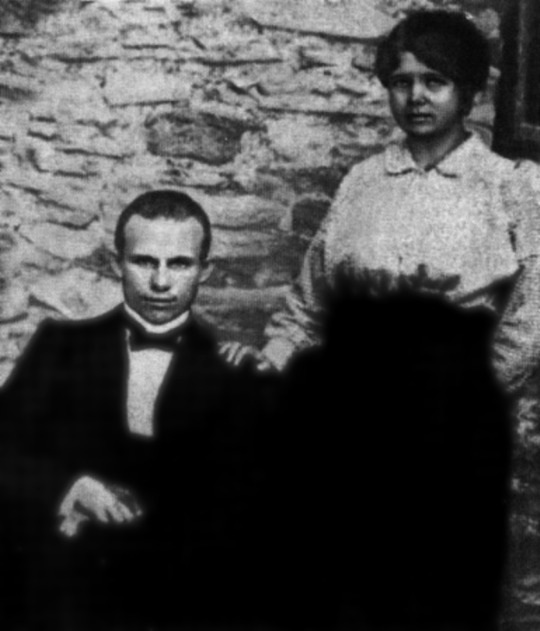
Metal worker Nikita Sergeevich Khrushchev with his first wife, Efrosinia Ivanovna Pisareva. 1916.
#BW#Black and White#Preto e Branco#Noir et Blanc#黒と白#Schwarzweiß#retro#vintage#Nikita Khrushchev#Efrosinya Pisareva#portrait#retrato#Celebs#celebridade#ポートレート#肖像#Porträt#Berühmtheit#有名人#名士#célébrité#history#historico#histoire#história#Geschichte#記録#史籍#由来#couples
25 notes
·
View notes
Link
1 note
·
View note
Text
Rus askerlerine çağrı: Teslim olun, Bitcoin verelim!
Rus askerlerine çağrı: Teslim olun, Bitcoin verelim!
Rusya’nın Ukrayna’yı işgali iki ülkenin para birimlerinde ciddi düşüşlere neden olurken, Ukrayna’ya yapılan kripto para bağışları dünya tarihinde bir ilk oldu. Kripto paraların değeri bir kez daha anlaşılırken, yine kripto para odaklı bambaşka bir iddia ortaya atıldı.
Ukraynalı televizyon sunucusu ve Birleşmiş Milletler Nüfus Fonu’nun Ukrayna’daki fahri büyükelçisi Masha Efrosinia, şahıssel…

View On WordPress
0 notes
Text
#808: ‘Ivan the Terrible, Part I’ (1944) and ‘Ivan the Terrible, Part II’ (1958?), dir. Sergei Eisenstein
One of the occasions where the list bends the ‘1,001′ thing even further by lumping two films together. The reason the dates are listed strangely is because I’m not quite sure how to categorise this - the two films (and some of the work on Part III, which was destroyed) were shot simultaneously, and while Stalin approved of Part I, which shows Tsar Ivan IV (Nikolay Cherkasov) uniting Russia despite the death of his wife, Part II, which doesn’t look too kindly on the Tsar, was banned until several years after Stalin’s death. Let this be a lesson to all those aspiring heads of state: if you see yourself as a historical figure, make sure said historical figure didn’t do anything too horrible.
Eisenstein’s style had changed significantly over the previous twenty years when he set out to make Ivan the Terrible. While his early films like Strike and Potemkin were fast and kinetic, their editing driven by rhythm and symbolic matches (like cutting from a preening general to a mechanical peacock), Ivan the Terrible is stately and slow. Many of Eisenstein’s framing and editing choices seem to have been based on visual style and choreography. Given the central importance of choreography here, and the reliance on music and song - the score composed by Sergei Prokofiev - Eisenstein has less made a pair of films than constructed an opera for the medium of film. The dedication to this theatrical mode is staggering.

In a further progression from his earlier work, Eisenstein corrals hundreds of extras to give his scenes an epic feeling. When extras are employed in a film like October, they are often given character and become more believable as a result. In Ivan, Eisenstein is writing fable, and his extras are often employed to display grandeur. This is the case when hundreds of citizens come to the monastery in Part I to request Ivan’s return to Moscow - the procession snakes across the desert and is perfectly disciplined, even though hundreds of extras are too distant to be able to decipher. The battle scenes and banquets are similarly populated, and when there are few people in a scene, the massive spaces are even more pronounced. The court of the Polish king at the start of Part II is warehouse-sized, and its checkerboard tiles seem to stretch out forever. When the space is only occupied by a messenger and a noble, Eisenstein still shoots from a distance as though the space is full, and the theatrical nature of the work comes to the fore again.
In Part I, Eisenstein returns over and over again to one visual image: Ivan towering over everyone else in the scene. While it is an image that usually has a benevolent intention, as in the famous shot from Part I where Ivan, in the foreground, bends over the parade of citizens snaking into the distance, it carries with it the seeds of dictatorship that will come to the fore in Part II. One of the most interesting uses of this motif is when Ivan is instructing his aide to send a chess set to Queen Elizabeth I. The content of the scene is prosaic and bland, although it does have some payoff later on. What makes the scene intriguing is the use of shadows. Ivan’s shadow is shown at one point looming over a globe, which in turn dwarfs his aide, showing the clear hierarchy of the three. Throughout the scene, though, the tall back wall has Ivan’s profile emblazoned across it:

That’s not actually the actor’s shadow: it’s a puppet with a moving mouth, being cast across the room from somewhere near the throne. Although Ivan is physically small within the frame, the scenography makes him large.
I feel like the structures of opera are the best way to understand these films, both in terms of content - the figure who undergoes tragedy and is ultimately shaped by it - and style. Eisenstein briefly employs colour film to add an extra shock to the bacchanalia of Part II, and never passes up an opportunity to have a character moment developed through song, such as when the scheming Efrosinia (Serafima Berman), who wants to get her naive son Vladimir (Pavel Kadochnikov) onto the throne, sings a lullaby to Vladimir about his future coronation. When Ivan, through scheming and a case of mistaken identity, has Vladimir assassinated at the end of Part II, Efrosinia brokenly sings a reprise of the same song to his corpse. Characters also seem at times to have foreknowledge of their own roles in the story, a meta-statement that hearkens back to theatrical performance as well. When Ivan unwittingly uses Efrosinia’s poisoned goblet to quench his wife’s thirst, Anastasia (Lyudmila Tselikovskaya) drinks from the cup with a look of anticipatory terror on her face, shying away momentarily from the drink. The terrible irony of the situation is lost on nobody but Ivan, it seems.
It’s not hard to see why Stalin disliked the second part of this film intensely. Rather than being a benevolent figure who is often the largest person in the room, Cherkasov plays Ivan as a smaller, mortal man who still believes himself to be tremendous. Although Efrosinia’s treatment of her son and single-minded devotion to have Ivan assassinated sets her up as a clear villain, emphasised through performance and costume, her response to Valdimir’s death is genuinely affecting and makes Ivan’s development into a villain conclusive. Ivan the Terrible is a slow slog at times, but its even-handed treatment of its characters is great, and the film remains important if only because of its role in the history of censorship. We’ll never know what Eisenstein intended to do with Part III; if he intended to redeem Ivan or send him further into a villainous spiral. I wish we could find out.
17 notes
·
View notes
Text
Sergei Eisenstein’s “Ivan the Terrible”: Part I vs Part II
Even though Part III wasn't finished (and what had been filmed was destroyed), Part I and II still form a rounded, coherent narrative, with a lot of parallel scenes. Part I features victorious war with enemies outside the country borders. Part II is about dealing with enemies within: within the country, within the family - and about demons lurking in every human soul.
Part I places Ivan upon a pedestal. Part II presents a brutal deconstruction of everything built up in Part I. The leitmotif of Part II is inversion, masquerade, chaotic carnival: mock wedding feast, mock coronation, mock tsar... Carnival is a reversal ritual, in which social roles are reversed and norms about desired behavior are suspended.
Part I begins in the cathedral, with a close-up shot of the crown. By the end of Part II we see the same crown in the same cathedral, now cradled by a grieving mother. Joyous, smiling, brightly dressed people at the beginning - and the silent, ominous Oprichniki with their faces hidden under black cowls in the end. Two mothers, fighting for the sake of their children - Anastasia and Efrosinia...
Both parts include the coronation scenes:


Both parts feature a murder: Anastasia and Vladimir. And in both cases the victim is inadvertently killed by the one who loves them the most: Ivan gives poison to Anastasia, Vladimir is stabbed by the assassin sent by his mother.
(Initially I wrote here that "both parts feature a murder of an innocent", but in fact there are no truly innocent people in the world of Ivan the Terrible, no black and white, only shades of grey. The characters are not cardboard cutouts, but humans, with their own shortcomings:
Anastasia encourages Ivan to deal with the boyar by heating his anger against them - so much that they believe that removing her would be enough to change the tsar's politics. During Ivan's illness Anastasia is not above exploiting Andrei Kurbsky’s feelings, if it can help to win over Efrosinia, secure Andrei's loyalty and establish Ivan’s son as the next tsar.
Vladimir's sole motivation is sloth. He doesn't sin much not due to his inherent goodness but because sinning is too much of a bother. Vladimir is against sending Pyotr as an assassin to Ivan - but only because he can't bear to see Pyotr’s face afterwards. Efrosinia consoles him by saying that they'll execute Pyotr as a scapegoat after the deed is done - and Vladimir is totally fine with that.)
Anastasia smiles at white swans in Part I - Vladimir reacts to black swans with the same childish amusement:


Both parts include the banquet scenes: the marriage celebration in Part I, the Oprichniki feast in Part II. White swans with silver crowns vs black swans with golden crowns, the festive hymn for the newlywed vs Fyodor's song about murder. The lyrics of these songs echo each other: "Open the gates, greet the newlywed..." vs "Hack the gates with axes, chop the boyars' heads off..."
Fyodor sings about breaking into a boyar mansion, slaughtering everyone, taking the valuables and burning down the place. The film doesn't include any gruesome scenes of bloodshed or tortures, but this song is enough to demonstrate how trivial the violence is for the Oprichniki: mass murder is treated as a casual and amusing activity.
During the wedding feast Anastasia wears pearl temple pendants. In Part II these pendants are tellingly attached to Fyodor’s mask, hinting at him replacing Anastasia: holy union blessed by church vs unholy, "unnatural" union with Fyodor.

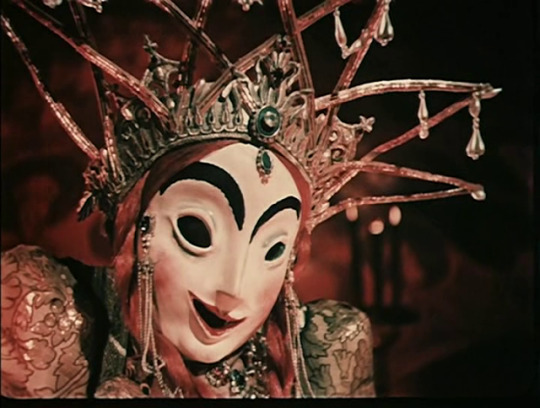
However, it's Vladimir who takes the bride's place at the feast in Part II. Both Alexei and Fyodor are shown jealous to the attention Vladimir receives. Alexei's outburst sets the ground for the future conflict in Part III and foreshadows Alexei's downfall: he doesn't understand Ivan as Malyuta does, and he isn't trusted as Fyodor. Alexei attempts to impose his will on the tsar, just as boyars did; he wants more power for himself. Fyodor's jealousy is triggered by Ivan's words "No one loves me...". He stops dancing and removes the mask, and Ivan reassures him with a glance.
The tsar and his accomplices display almost supernatural understanding, akin to a hive-mind: after Fyodor notices the would-be assassin, Ivan immediately realizes what’s going on, and he doesn't need words or gestures to give Malyuta the order to act. This whole sequence is played as if they are communicating by means of telepathy.
The Oprichinki feast is filmed in color. The high-contrast red lighting makes this scene surreal as if the action takes place in hell. It is during this episode that Ivan wholly assumes the role of devil, displaying almost supernatural ability to manipulate his followers and enemies alike. The feast reminds a witches' sabbath, a devilish hallucination. This impression is strengthened when the colorful sequence is interrupted by a brief black-and-white scene with Pyotr waiting inside the church: as if Vladimir for a moment has managed to shake off the hypnosis or to awaken from a nightmare.
The Oprichniki in the finale represent the realm Ivan is building: dark, voiceless, faceless, featureless:

At the same time, this scene also shows Ivan’s loneliness, an absolute solitude of an autocrat ruler. There are no people anymore near Ivan since the Oprichniki are nothing but the tsar’s shadows. Instead of feeling safe, Ivan only sinks deeper into despairing isolation.
<<Previous Next>>
33 notes
·
View notes
Text
Sergei Eisenstein’s “Ivan the Terrible”: shadows, murals, eyes and creepy faces
Shadows live their own life and tell their own, parallel tale:

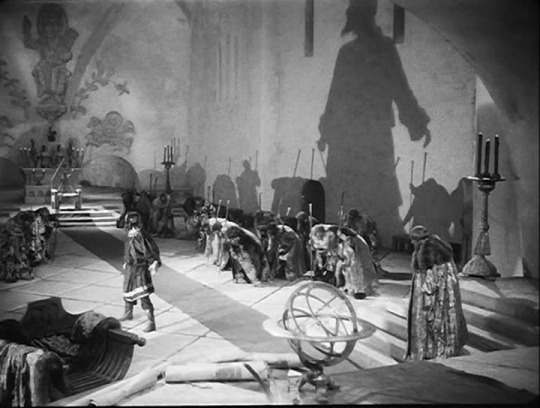
The murals on the walls also play an extremely important role and establish the composition and tone of many scenes.
The throne room is dominated by the huge mural of the Wrathful Angel (Archangel Michael) trampling the Universe under his feet. The mural is so big it couldn’t even fit into a single shot, and Eisenstein's drawings are the only way to see what it's supposed to look like:

During Anastasia's memorial service her murderer Efrosinia stops near a fresco with a sinner cast by Archangel Michael into hellfire:

Ruthless bishop Pimen with his scull-like face is associated with the Grim Reaper:
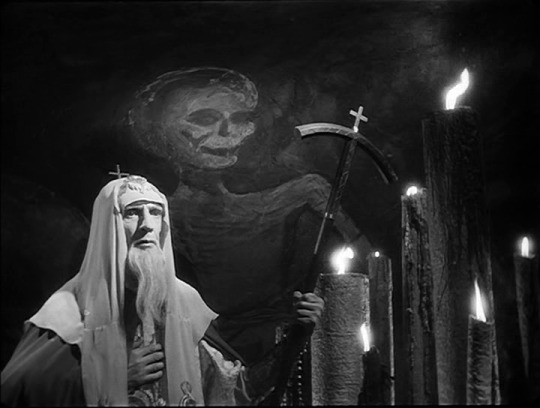
In Ivan the Terrible walls do have ears, and eyes as well - sometimes even too many of them. Eyes of god, eyes of saints, eyes of people... The characters are always being watched.


There are even eyes inside eyes if you look closely:
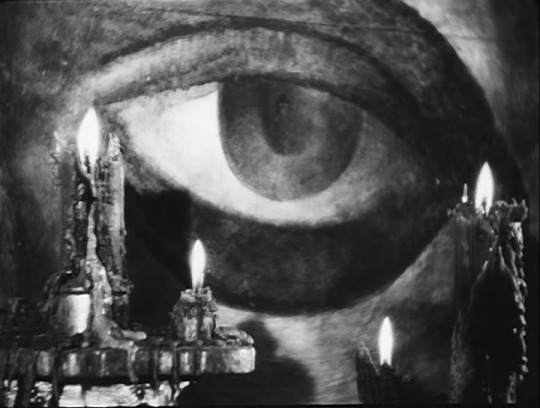
The eyes on the walls are the eyes of god. Since Ivan seeks to usurp the god's place, torturer Malyuta serves as Ivan's ever-watching eye, always looking for any signs of treason:

As the story progresses, the faces on the walls seem more and more disturbing, bizarre and phantasmagorical.



This parade of crazy faces culminates in Fyodor’s mask, with it’s distorted, asymmetrical features - the face of madness. In contrast with icons and frescoes, the mask is eyeless. I absolutely adore this mask: its unsettling appearance wouldn't feel out of place in a horror game or movie (hello, my beloved BioShock I with creepy splicers' masks).
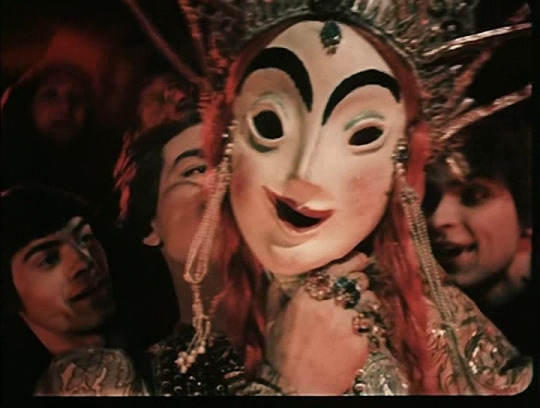
<<Previous Next>>
43 notes
·
View notes
Text
Sergei Eisenstein’s “Ivan the Terrible”

First of all - it would be a mistake to treat Ivan the Terrible as a historical film. The stylization after opera and Shakespeare's plays, such as Hamlet, King Lear, Macbeth, is deliberate: Eisenstein himself defined Ivan the Terrible as "tragedy in the Shakespearean mode". Indeed: this film tells about real Ivan IV, the first Russian tsar, as much as Hamlet tells about real 12th-century Amleth.
Ivan the Terrible sacrifices historicity for the sake of aesthetics and story: many important events are simplified or omitted, the chronology is not always correct, Ivan IV was officially married at least 4 times, Efrosinia Staritskaya wasn't the sole head of the boyar opposition, Vladimir Staritsky wasn't mentally deficient, Grigory "Malyuta" Skuratov entered the tsar retinue well after the depicted events, the Basmanovs weren't commoners, etc.
By many inaccuracies and generalizations Eisenstein makes the point that he creates neither biopic nor historical epic, but a many-layered timeless parable. As the first opening credits say, in large letters: "This is a film about a man...". It’s hard to add anything more specific because of all the themes Ivan the Terrible incorporates. Is it about tyranny? Or about a man assuming the role of god? Or being lonely at the top? Or is it a desperate outcry against cruelty and autocracy? Or about the road to hell which is paved with good intentions? About revenge and retaliation - the cycle of violence which never breaks?
Like with Mona Lisa's smile - a multitude of interpretations is possible.
Ivan the Terrible combines both the elements of the classical European theater based on Shakespeare's plays, and the Asian theatrical tradition with its emphasize on gesture, pose, movement. The characters' faces seem to be inspired by Renaissance paintings but the body language is influenced by Noh and Kabuki performance. And the Peking opera, of course: not surprising, considering Eisenstein's friendship with Mei Lanfang, the famous performer of female roles, whom he filmed during Mei Lanfang's visit to USSR in 1935.
The actors speak in over-the-top theatrical, unnatural manner. Their movements are symbolic and suggestive, rather than realistic. Similar to Peking opera, Ivan the Terrible presents idealized, generalized images, that convey spiritual likeness of people, which stimulates viewer's imagination - not just a formal, physical resemblance.

While working on the film, Eisenstein thought in terms of lines, shapes, rhythm, and he demanded from actors a special kind of movement plastic. Eisenstein even wanted to cast great ballerina Galina Ulanova as Anastasia. As he wrote in the diary, "an act of movement is at the same time an act of thinking, and a thought - at the same time - is an action in space" ("двигательный акт есть одновременно акт мышления, а мысль - одновременно - пространственное действие"). This approach is especially noticeable in the scene where Ivan tries to stop metropolitan Philip from leaving in Part II - it’s a peerless choreographic sequence, with all that cloak pulling and mantle trampling.
I can only wonder - why Ivan the Terrible hasn’t been made into an opera yet?! Sergei Prokofiev’s score is magnificent. The film contains so much singing that it's already almost an opera: the wedding celebration hymn, the song of cannoniers, the Fiery Furnace performance, Efrosinia’s lullaby, Fyodor’s song... The frenzied dance of the Oprichniki in Part II reminds of the Polovtsian Dances from Prince Igor.

It's worth noting that "Ivan the Terrible" is a mistranslation. Ivan’s nickname, "Grozny", has nothing to do with terror and doesn't have a bad meaning. Sometimes it's translated into English as "Ivan the Fearsome", which is slightly more correct. In fact, the adjective "grozny" is derived from the Russian word "groza" - "thunderstorm". (That's why thunderstorm clouds serve as background for the film credits.) In older Russian "groza" also meant "threat" (the modern form - "ugroza"). One of the Russian dictionaries explains the word "grozny" as "courageous, magnificent, magisterial and keeping enemies in fear, but people in obedience". But, in my opinion, the best definition is provided by TVtropes.org: "terrifying yet awesome" - like a thunderstorm.

Another thing which may be confusing for a non-Russian viewer is who were the Oprichniki and why they are considered bad guys. In short, the Oprichniki were the tsar's personal punitive army with a dash of Inquisition. They dressed in black and emulated the monastic life; they weren't controlled by laws and answered only to the tsar. With their help Ivan IV established his autocratic reign: in uprooting any opposition the Oprichniki extensively used tortures, mass murders and gruesome executions.
Next >>
45 notes
·
View notes
Text
Sergei Eisenstein’s “Ivan the Terrible”: Basil Fool for Christ
This icon of the Russian Orthodox saint, Basil Fool for Christ, appears in the scene with the last rites when Ivan is taking the monastic vows (the monastic vows were customary for the Russian princes and tsars before death):

Basil, "holy fool for Christ", or “yurodivy”, died in 1552 and was canonized during the later years of Ivan IV’s reign, in 1580, so his icons couldn’t have existed yet. But the reminder of this saint sheds more light on Ivan's personality: historically, Ivan IV greatly respected Basil for always telling the truth despite ranks and status, even rebuking the tsar himself. Apparently, the "holy fool for Christ" tradition had a special meaning for the tsar: Ivan IV used the alias of "Parthenius Yurodivy" for some of his literary works (such as the canon (hymn) for Archistrategos Mikhail the Fearsome Angel).
In the context of Ivan's illness, a naked man standing before god, with nothing separating them, is a metaphor of Ivan's soul ready to depart earth to face divine judgement, and a symbol of atonement. But in the context of the entire film, Saint Basil, a man who refused to own anything, serves as the antithesis of the tsar who seeks to own all, even people's souls.
The "holy fool for Christ" Nikolai, the instigator of the riot in Part I and the aide of Efrosinia, is probably modeled after Saint Basil: he is naked and weighed down with chains. Although this kind of "attire" was typical for the Russian "holy fool for Christ" tradition:

<<Previous Next>>
16 notes
·
View notes